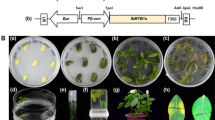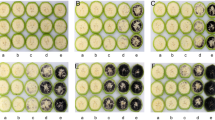Abstract
Manipulating flavonoid biosynthesis by genetic engineering in economically important crop plants is an emerging area of importance in plant biotechnology. Banana, which is the world most important fruit crop by production volumes, is rich in proanthocyanidins. We hypothesized that by downregulating the critical proanthocyanidin synthesis branch point enzyme, namely anthocyanidin reductase (MusaANR1) using intron-mediated hairpin RNA against its transcript, the levels of the end product of the other branch of phenylpropanoid pathway could be enhanced. Although, the transcript levels of MusaANR1 were successfully downregulated in transgenic banana plants, there was no significant elevation in the levels of anthocyanin in transgenic banana tissues.





Similar content being viewed by others
References
Abeynayake SW, Panter S, Chapman R, Webster T, Rochfort S, Mouradov A, Spangenberg G (2012) Biosynthesis of proanthocyanidins in white clover flowers: cross talk within the flavonoid pathway. Plant Physiol 158:666–678
Bajec MR, Pickering GJ (2008) Astringency: mechanisms and perception. Crit Rev Food Sci Nutr 48:858–875
Bogs J, Downey MO, Harvey JS, Ashton AR, Tanner GJ, Robinson SP (2005) Proanthocyanidin synthesis and expression of genes encoding leucoanthocyanidin reductase and anthocyanidin reductase in developing grape berries and grapevine leaves. Plant Physiol 139:652–663
Carron TR, Robbins MP, Morris P (1994) Genetic modification of condensed tannin biosynthesis in Lotus corniculatus. 1. Heterologous antisense dihydroflavonol reductase down-regulates tannin accumulation in ‘hairy root’ cultures. Theor Appl Genet 87:1006–1015
Davies KM (ed) (2004) Plant pigments and their manipulation. Annual plant reviews, vol 14. Blackwell Publishing, Oxford
Dixon RA, Xie DY, Sharma SB (2005) Proanthocyanidins: a final fronter in flavonoid research? New Phytol 165:9–28
Edgerton MD (2009) Increasing crop productivity to meet global needs for feed, food, and Fuel. Plant Physiol 149:7–13
Ffoulkes D, Espejo S, Marie D, Delpeche M, Preston TR (1977) The banana plant as cattle feed: composition and biomass production. Trop Anim Prod 3:45–50
Fischer TC, Mirbeth B, Rentsch J, Sutter C, Ring L, Flachowsky H, Habegger R, Hoffmann T, Hanke M-V, Schwab W (2014) Premature and ectopic anthocyanin formation by silencing of anthocyanidin reductase in strawberry (Fragaria × ananassa). New Phytol 201:440–451
Fukui Y, Tanaka Y, Kusumi T, Iwashita T, Nomoto K (2003) A rationale for the shift in colour towards blue in transgenic carnation flowers expressing the flavonoid 3′,5′-hydroxylase gene. Phytochemistry 63:15–23
Ganapathi TR, Higgs NS, Balint-Kurti PJ, Arntzen CJ, May GD, Van Eck JM (2001) Agrobacterium-mediated transformation of the embryogenic cell suspensions of the banana cultivar Rasthali (AAB). Plant Cell Rep 20:157–162
Gatica-Arias A, Stanke M, Häntzschel K, Matoušek J, Weber G (2013) Over-expression of the transcription factor HIMYB3 in transgenic hop (Humulus lupulus L. cv. Tettnanger) modulates the expression of genes involved in the biosynthesis of flavonoids and phloroglucinols. Plant Cell Tissue Organ Cult 113:279–289
Ghag SB, Shekhawat UKS, Ganapathi TR (2012) Petunia floral defensins with unique prodomains as novel candidates for development of Fusarium wilt resistance in transgenic banana plants. PLoS One 7:e39557
Ghag SB, Shekhawat UKS, Ganapathi TR (2014a) Transgenic banana plants expressing a Stellaria media defensin gene (Sm-AMP-D1) demonstrate improved resistance to Fusarium oxysporum. Plant Cell Tissue Org Cult 119:247–255
Ghag SB, Shekhawat UKS, Ganapathi TR (2014b) Native cell-death genes as candidates for developing wilt resistance in transgenic banana plants. AoB Plants. doi:10.1093/aobpla/plu037
Ghag SB, Shekhawat UKS, Ganapathi TR (2014c) Host induced post-transcriptional hairpin RNA-mediated gene silencing of vital fungal genes confers efficient resistance against Fusarium wilt in banana. Plant Biotechnol J 12:541–553
Hayashi N, Ujihara T, Kohata K (2005) Reduction of catechin astringency by the complxation of gallate-type catechins with pectin. Biosci Biotechnol Biochem 69:1306–1310
He S, Shan W, Kuang JF, Xie H, Xiao YY, Lu WJ, Chen JY (2013) Molecular characterization of a stress-response bZIP transcription factor in banana. Plant Cell Tissue Org Cult 113:173–187
Katongolea CB, Bareebaa FB, Sabiitib EN, Ledin I (2008) Nutritional characterization of some tropical urban market crop wastes. Anim Feed Sci Technol 142:275–291
Katsumoto Y, Fukuchi-Mizutani M, Fukui Y, Brugliera F, Holton TA, Karan M, Nakamura N, Yonekura-Sakakibara K, Togami J, Pigeaire A, Tao GQ, Nehra NS, Lu CY, Dyson BK, Tsuda S, Ashikari T, Kusumi T, Mason JG, Tanaka Y (2007) Engineering of the rose flavonoid biosynthetic pathway successfully generated blue-hued flowers accumulating delphinidin. Plant Cell Physiol 48:1589–1600
Kimambo AE, Muya HMH (1991) Rumen degradation of dry matter and organic matter of different parts of the banana plant. Livest Res Rural Dev 3:35–40
Kovinich N, Saleem A, Rintoul TL, Brown DC, Arnason JT, Miki B (2012) Coloring genetically modified soybean grains with anthocyanins by suppression of the proanthocyanidin genes ANR1 and ANR2. Transgenic Res 21:757–771
Manach C, Scalbert A, Morand C, Rémésy C, Jimenez L (2004) Polyphenols: food sources and bioavailability. Am J Clin Nutr 79:727–747
Marie-Magdeleine C, Boval M, Philibert L, Borde A, Archimède H (2010) Effect of banana foliage (Musa × paradisiaca) on nutrition, parasite infection and growth of lambs. Livest Sci 131:234–239
McSweeney CS, Palmer B, McNeill DM, Krause DO (2001) Microbial interactions with tannins: nutritional consequences for ruminants. Anim Feed Sci Technol 91:83–93
Min BR, Pinchak WE, Fulford JD, Puchala R (2005) Wheat pasture bloat dynamics, in vitro ruminal gas production and potential bloat mitigation with condensed tannins. J Anim Sci 83:1322–1331
Mohapatra D, Mishra S, Sutar N (2010) Banana and its by-product utilization: an overview. J Sci Ind Res 69:323–329
Mura K, Tanimura W (2003) Change of polyphenol compounds in banana pulp during ripening. Food Preserv Sci 29:347–351
Nguyen TBT, Ketsa S, van Doorn WG (2003) Relationship between browning and the activities of polyphenol oxidase and phenylalanine ammonia lyase in banana peel during low temperature storage. Postharvest Biol Technol 30:187–193
Pazmiño-Durána EA, Giustib MM, Wrolstadc RE, Glória MBA (2001) Anthocyanins from banana bracts (Musa × paradisiaca) as potential food colorants. Food Chem 73:327–332
Pfaffl MW, Horgan GW, Dempfle L (2002) Relative expression software tool (REST) for group-wise comparison and statistical analysis of relative expression results in real-time PCR. Nucleic Acid Res 30:e36
Porter LJ, Hrstich LN, Chan BG (1986) The conversion of procyanidins and prodelphinidins to cyanidin and delphinidin. Phytochemistry 25:223–230
Ratanasut K, Monmai C, Piluk P (2015) Transient hairpin RNAi-induced silencing in floral tissues of Dendrobium Sonia ‘Earsakul’ by agroinfiltration for rapid assay of flower colour modification. Plant Cell Tissue Organ Cult 120:643–654
Reed JD (2001) Effects of proanthocyanidins on digestion of fiber in forages. J Range Manage 54:466–473
Robbins MP, Bavage AD, Strudwicke C, Morris P (1998) Genetic manipulation of condensed tannins in higher plants. II. Analysis of birdsfoot trefoil plants harboring antisense dihydroflavonol reductase constructs. Plant Physiol 116:1133–1144
Roux N, Baurens FC, Dolezel J, Hribova E, Heslop-Harrison P, Town C, Sasaki T, Matsumoto T, Aert R, Remy S, Souza MT Jr, Lagoda P (2008) Genomics of banana and plantain (Musa spp.), major staple crops in the tropics. In: Moore PH, Ming R (eds) Genomics of tropical crop plants. Springer, New York, pp 83–111
Santos JRU, Bakry F, Brillouet JM (2010) A preliminary chemotaxonomic study on the condensed tannins of green banana flesh in the Musa genus. Biochem Syst Ecol 38:1010–1017
Seitz C, Vitten M, Steinbach P, Hartl S, Hirsche J, Rathje W, Treutter D, Forkann G (2007) Redirection of anthocyanin synthesis in Osteospermum hybrida by a two-enzyme manipulation strategy. Phytochemistry 68:824–833
Sharma M, Cortes-Cruz M, Ahern K, McMullen M, Brutnell TP, Chopra S (2010) Identification of the Pr1 gene product completes the anthocyanin biosynthesis pathway of maize. Genetics 110:126–136
Shekhawat UKS, Ganapathi TR (2014) Transgenic banana plants overexpressing MusabZIP53 display severe growth retardation with enhanced sucrose and polyphenol oxidase activity. Plant Cell Tiss Org Cult 116:387–402
Shekhawat UKS, Ganapathi TR, Hadapad AB (2012) Transgenic banana plants expressing small interfering RNAs targeted against viral replication initiation gene display high-level resistance to banana bunchy top virus infection. J Gen Virol 93:1804–1813
Soares S, Mateus N, De Freitas V (2012) Carbohydrates inhibit salivary proteins precipitation by condensed tannins. J Agric Food Chem 60:3966–3972
Suzuki K, Xue H, Tanaka Y, Fukui Y, Fukuchi-Mizutani M, Murakami Y, Katsumoto Y, Tsuda S, Kusumi T (2000) Flower color modifications of Torenia hybrida by co-suppression of anthocyanin biosynthesis genes. Mol Breed 6:239–246
Tanaka T, Kondou K, Kouno I (2000) Oxidation and epimerization of epigallocatechin in banana fruits. Phytochemistry 53:311–316
Tanner GJ, Francki KT, Abrahams S, Watson JM, Larkin PJ, Ashton AR (2003) Proanthocyanidin biosynthesis in plants. Purification of legume leucoanthocyanidin reductase and molecular cloning of its cDNA. J Biol Chem 278:31647–31656
Tock JY, Lai CL, Lee KT, Tan KT, Bhatia S (2010) Banana biomass as potential renewable energy resource: a Malaysian case study. Renew Sustain Energy Rev 14:798–805
Tsuda S, Fukui Y, Nakamura N, Katsumoto Y, Yonekura-Sakakibara K, Fukuchi-Mizutani M, Ohira K, Ueyama Y, Ohkawa H, Holton TA, Kusumi T, Tanaka Y (2004) Flower color modification of Petunia hybrida commercial varieties by metabolic engineering. Plant Biotechnol 21:377–386
Xie DY, Sharma SB, Paiva NL, Ferreira D, Dixon RA (2003) Role of anthocyanidin reductase, encoded by BANYULS in plant flavonoid biosynthesis. Science 299:396–399
Yang J, Tan H, Zhai H, Wang Q, Zhao N, Cai Y, Li M, Zhou H (2012) Research on chemical composition and ensiling characteristics of banana stems and leaves. Adv Mater Res 4347–4353:1647–1651
Zhao J, Dixon RA (2009) MATE transporters facilitate vacuolar uptake of epicatechin 3′-O-glucoside for proanthocyanidin biosynthesis in Medicago truncatula and Arabidopsis. Plant Cell 21:2323–2340
Zhou LL, Zeng HN, Shi MZ, Xie DY (2008) Development of tobacco callus cultures over expressing Arabidopsis PAP1/MYB75 transcription factor and characterization of anthocyanin biosynthesis. Planta 229:37–51
Zuluaga DL, Gonzali S, Loreti E, Pucciariello C, Degl’Innocenti E, Guidi L, Alpi A, Perata P (2008) Arabidopsis thaliana MYB75/PAP1 transcription factor induces anthocyanin production in transgenic tomato plants. Funct Plant Biol 35:606–618
Acknowledgments
Authors would like to thank Dr. S. P. Kale, Head, Nuclear Agriculture and Biotechnology Division, BARC for his support and encouragement.
Author information
Authors and Affiliations
Corresponding author
Additional information
Siddhesh B. Ghag and Upendra K. S. Shekhawat have contributed equally to this work.
Electronic supplementary material
Below is the link to the electronic supplementary material.
Rights and permissions
About this article
Cite this article
Ghag, S.B., Shekhawat, U.K.S. & Ganapathi, T.R. Silencing of MusaANR1 gene reduces proanthocyanidin content in transgenic banana plants. Plant Cell Tiss Organ Cult 121, 693–702 (2015). https://doi.org/10.1007/s11240-015-0739-x
Received:
Accepted:
Published:
Issue Date:
DOI: https://doi.org/10.1007/s11240-015-0739-x




